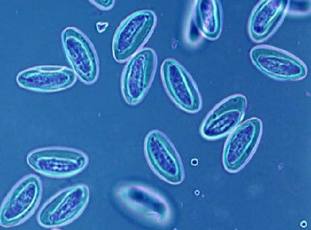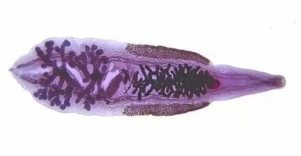
Helminth infections – one of the most common diseases in children and adults. In the body of the man may infest different types of worms. There is an opinion, far from the medicine, that the helminth does not affect the digestive tract, in fact, the worms can infest on almost all the internal organs – the liver, the lungs, the heart, the brain of the head, as well as in the muscle tissue, the subcutaneous tissue and eye. In the article, the earthworms are to man.
Classification
There is a huge amount of worms that can hit the man, below are the most common of them. Most earthworms belong to any of the 3 groups – trematodes, cestodes or nematodes.
The trematode is a class of parasites to platform, we know of about 40 species of earthworms that struck the man. The most common:
- grass, cat or siberian fluke causing opisthorchiasis);
- schistosoma (causing schistosomiasis).
Tapeworm is a strip tape worms. The representatives of the cestodes lack digestive system. The more often the man hit:
- wave of tsepen (causes beef tapeworm infection);
- swine tsepen (causing cysticercosis);
- Echinococcus (head of echinococcosis).
Nematodes are round worms, they are abdominal. Common helminths, striking the man:
- pinworms;
- ascaris;
- the whipworm.
Intestinal worms in humans, symptoms of the most de-worming hits the GASTROINTESTINAL tract, thence, nausea and vomiting, diarrhea or constipation, intestinal obstruction, anger for no reason weight loss, lack of appetite or over-fishing and the hungry):
Grass, cat or siberian fluke

Grass, cat or siberian fluke – a parasite-form, lanceolate, the group of liver flukes. The causative agent of the disease opisthorchiasis. In the length of the moat reached 8 mm to 18 mm, width: 1.2-2 mm wide, the Parasite develops in the bodies of the two masters — intermediate and final. An intermediate host, molluscs and fish, carp, final – people.
With the feces of infected people and animals, the eggs fall into fresh water, where they swallow the shellfish. In the body of the mollusk eggs reach invasive stage, the cercaria, cercariae leave the snail and put in place in the body of the carp, or are in their body by eating fish shellfish. In a body of the fish parasite develops in meta cercaria, located in the cyst, its size reached 0.17 to 0.21 mm
By eating infected fish infected by a man, in his body meta cercaria leave cysts, the stomach and the intestine, they pass into the liver and bile ducts. In these organs, they remain to free-ride, and after 10-12 days to reach the Mature stage, begin to lay eggs. In the body of a man, a cat flukes can infest 10 to 20 years.
Schistosoma
Schistosoma – the gills. It is the flat dioecious helminths in length is approximately 4 to 20 mm, width of 0.25 mm Body schistosoma is fitted with 2 suction the mouth and of the abdomen, they are located in close proximity to each other. The female schistosoma is longer and more slender than the males. On the body of the male is a longitudinal groove, with his help, it keeps the female. Eggs with a diameter of 0.1 mm, oval shape, on the surface of one of the poles is a great pic.
Human to schistosoma in the role of the definitive host choose the people, in their bodies, they are parasites in the small veins of the colon, the abdomen, the uterus, the bladder. Earthworms feed on blood, in part to suck nutrients through the cuticle. Eggs of schistosoma are transported in the intestine and the urinary bladder, where mature and standing out at the outside world with the faeces or urine. In freshwater, the water of the eggs between the larva of its interim master of the molluscs. In the body of the mollusk meta cercaria develop in the cercaria 4 to 8 weeks.
Wave of tsepen

Wave of tsepen – band parasite that causes the disease, beef tapeworm infection. This is a huge helminths, can reach 3 meters to 12 meters in length. On the body of the parasite is the small head of a diameter up to 3 mm, the neck of the uterus, and about 1000 segments. After penetration into the body of a person with non-heat-treated, infected meat lonely is attached to the wall of the intestine with the help of 4 suction cups.
In hermaphrodite segments are deposited the eggs of the worm, each year, a person lays up to 600 million eggs. These helminth parasites in humans, parasites in the intestine of 20 years and more, if the absence of prompt treatment.
Swine tsepen
Swine tsepen, such as the wave, on the body has 4 pads, but in addition to this, the body of the worm is fitted on the other and double whip krjuchev. Reaches two to three meters in length. Pork tapeworm-lobed ovary, each side of the uterus is 7 to 12 branches. The characteristic feature of this worm – the ability of segments out of the anal opening. After the output to the outside of their sheath is dry and bursts into the environment to fall the eggs of worm. Intermediate host the tapeworm can be of pig and man.
The main host of man. Intestinal parasites in humans include swine tapeworm, helminth parasites found in the intestine of the patient, where it lays its eggs. The infection occurs through the consumption of meat.
Echinococcus
The causative agent of Echinococcusoz in length is about 3-5 mm. Consists of the head, on which are placed the four suction cups and two corolla krjuchev, and three to four segments. The last of the segments has developed sexual system. An intermediate host, the livestock or the human, the definitive owner of the dogs, wolves. Infection occurs by the oral route.
Echinococcus enters the intestine, where the eggs yield larvae. Using krjuchev, the larvae penetrate into the system of the portal vein, where the blood echoes in the liver, the lungs, the muscle tissue.
Pinworms

Pinworms – roundworms, pathogens, enterobiasis, so-called disease of dirty hands. The greater the degree of contamination of pinworm children are exposed to. The infection occurs oral and contact-violence. You can find these worms in the stool.
The female worms genre pinworms in length reached from 5 to 10 mm, males – 3 millimeters. The shape of the body in pinworms fusiform milky white. The end of the body of the female is slightly tapered. The adult intestinal worms are parasites in the departments of the small intestine and large man, by fixing to the wall using the head of the vesicle. In order to lay eggs, the female pinworms travel to the rectum, exiting to the outside and lay their eggs in the area of the anus, after that, they perish. Deferred the eggs become invasive already in the 4 to 6 hours. The life span of the pinworm a month to two months.
Ascaris
The round – some representatives of the class of plant-parasitic nematodes, pathogens ascariasis. It is helminths yellowish pink in colour, have stretched the pin-shaped, dioecious. The female ascaris increase of 20 to 40 centimetres long, males reach a length of 15 centimetres to 25 centimetres. Each day, an adult female ascaris defers to more than 200 thousands of eggs, which, together with the fecal material of man to stand out in an outdoor environment, where through 12-14 days become invasive.
In the human body are parasites in the gastro-intestinal tract, locates predominantly in the small intestine. The complete cycle of development of invasive eggs to Mature phase lasts about 3 months.
Whipworm
Whipworm – helminths, causing trihozefalez. Helminths represent a thin brown nematodes thin thread-like front section and fixed to the rear end. The female whipworm grow up to 3.5-5.5 cm, and the males up to 3-4,5 cm. The larvae of helminths of man are localized in the cecum, where and are parasitic at one stage of sexual maturity, lay their eggs. When infestation is massive helminths may also occupy the large intestine, including the rectum.
Each day, the female whipworm lay 3,5 thousands of eggs. The eggs of the worm have the barrel shape, covered with a thick brown shell, on the poles are colorless "gate". The eggs drop into the soil with the droppings of the base of the host, in the presence of favourable conditions, they can retain invasive properties in two years. The duration of the in the human intestine, 5 to 7 years.







































